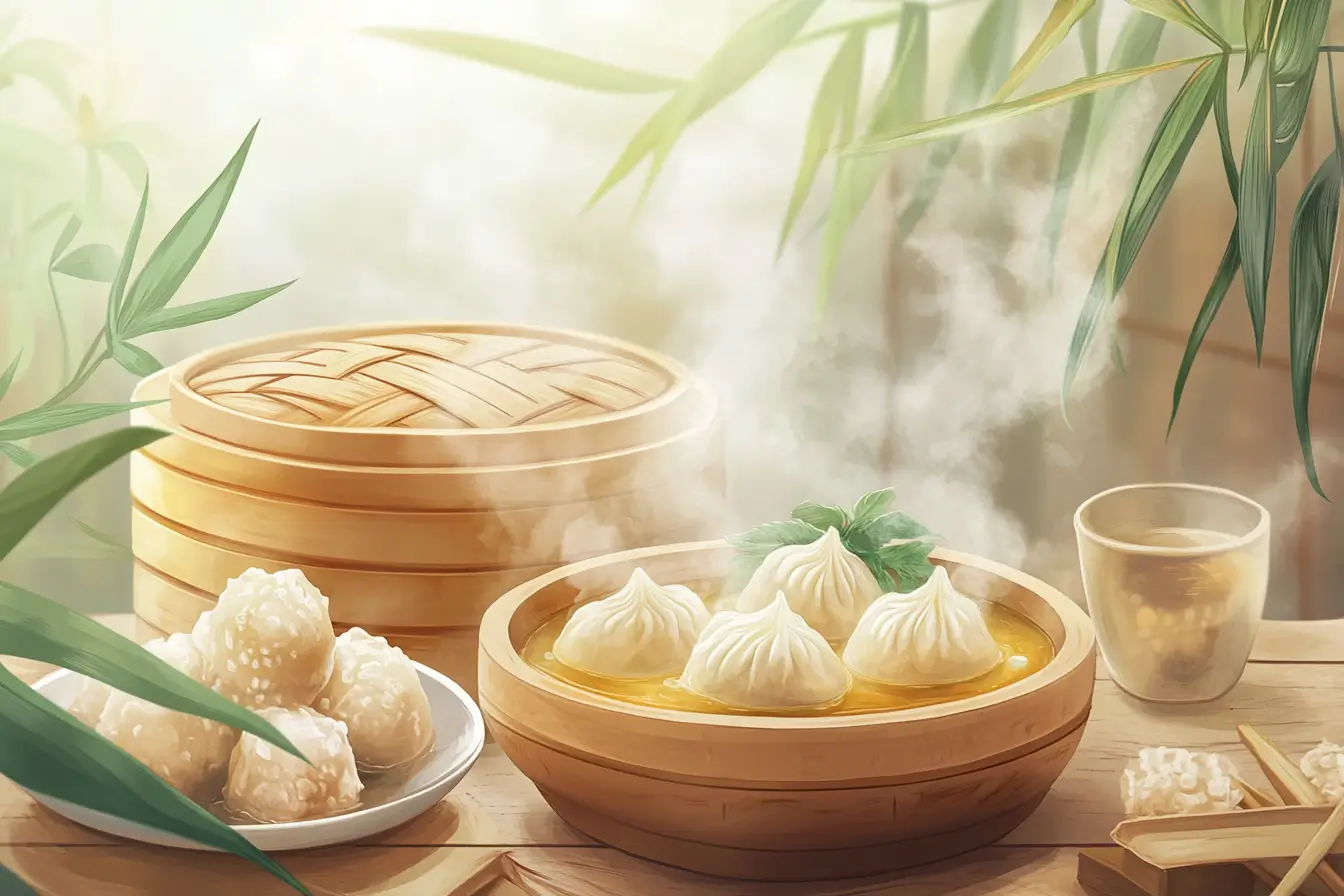If you’ve ever bitten into a soup dumpling and thought, “How does all that flavorful soup get in there?” you’re not alone. The secret is usually gelatin, which helps create those delicious soup pockets inside the dumpling wrapper. But what if you’re out of gelatin, don’t use it for dietary reasons, or just want another option? Don’t worry—I’ve got you covered! Let’s talk about substitute gelatin soup dumplings and the best alternatives for gelatin to ensure you can still enjoy that irresistible bite.
Why Is Gelatin Used in Soup Dumplings?
Gelatin solidifies broth when chilled, melting into soup during steaming. However, its animal-derived nature makes it unsuitable for vegan recipes. Exploring alternatives enables inclusivity without compromising taste or texture. For vegan-friendly options, discover how agar-agar and other substitutes can make vegan soup dumplings just as enjoyable.
Top Gelatin Substitutes for Soup Dumplings
Here are some tried-and-true options for replacing gelatin in your dumpling game:
1. Agar-Agar
- What it is: Agar-agar is a plant-based alternative made from red algae. It’s a popular substitute for gelatin in vegan cooking.
- Why it works: Like gelatin, agar-agar solidifies liquids when chilled. The main difference? Agar sets more firmly and melts at a higher temperature.
- How to use it: Dissolve agar-agar powder in hot broth (about 1 teaspoon per cup of liquid), let it cool, and refrigerate until it sets. Then, chop it into cubes before stuffing your dumplings.
2. Cornstarch and Water (a Slurry)
- What it is: This simple combo of cornstarch and water is a thickening agent you probably already have in your pantry.
- Why it works: While it won’t fully gel like gelatin, it thickens broth enough to hold its shape. It’s best for those who don’t mind slightly less liquid soup in their dumplings.
- How to use it: Add 1 tablespoon of cornstarch to 1 cup of hot broth, whisking until smooth. Let it cool, and use it immediately.
3. Xanthan Gum
- What it is: Xanthan gum is a plant-based thickener often used in gluten-free recipes.
- Why it works: It thickens liquids without needing heat, which is great for soup dumpling fillings.
- How to use it: Sprinkle about 1/8 teaspoon into a cup of broth and whisk until it thickens. Chill the mixture before adding it to your dumpling wrappers.
4. Arrowroot Powder
- What it is: Arrowroot is a natural starch that works like cornstarch but with a lighter finish.
- Why it works: It creates a slightly thicker broth that can still pass for soup in dumplings.
- How to use it: Mix 1 tablespoon of arrowroot powder with a cup of hot broth, whisk until smooth, and refrigerate until it thickens.
5. Kudzu (Japanese Arrowroot)
- What it is: Kudzu is a starch made from the Japanese arrowroot plant.
- Why it works: It thickens liquid into a soft gel, much like agar-agar, but with a slightly silkier texture.
- How to use it: Dissolve 1 tablespoon of kudzu in a little cold water, then stir it into 1 cup of hot broth. Cool and refrigerate.
A Step-by-Step Guide to Making Soup Dumplings Without Gelatin
Now that we’ve covered the substitutes, let’s talk about how to use them. Here’s a simple breakdown:
1. Prepare Your Broth
Start with a flavorful broth. Chicken, pork, or vegetable broth are all great options. Simmer it with aromatics like garlic, ginger, and scallions to make it extra tasty.
2. Choose Your Thickener
Pick one of the substitutes above and prepare it according to the instructions. Remember, agar-agar and xanthan gum are better for a firmer gel, while cornstarch or arrowroot will give you a looser consistency.
3. Cool and Set
Once you’ve mixed your thickener into the broth, let it cool to room temperature. Then refrigerate it until it’s firm enough to cut into cubes or scoop into small portions.
4. Assemble the Dumplings
Roll out your dumpling wrappers (store-bought is fine if you’re in a hurry—no judgment here!). Add a small amount of filling—usually ground pork or chicken—along with a cube of your jellied broth substitute.
5. Steam and Enjoy
Steam the dumplings until the wrappers are translucent, and the filling is cooked through. When you bite into them, the substitute will melt into a delicious soup. Yum!
Tips for Perfect Soup Dumplings
- Don’t overfill: It’s tempting to stuff in as much soup as possible, but too much will make the dumplings hard to seal.
- Chill everything: Cold fillings are easier to work with and keep the soup from seeping out while you’re assembling.
- Practice your pleats: Sealing soup dumplings can take some practice. Keep trying—it’s worth it!
What Makes Agar-Agar the Best Vegan Substitute for Gelatin?
Agar-agar isn’t just a random pick—it’s a superstar in the world of plant-based cooking. Unlike gelatin, which comes from animal collagen, agar-agar is derived from seaweed, making it 100% vegan and vegetarian-friendly. It works exceptionally well as a substitute for gelatin in soup dumplings because it creates a firm gel that holds up during steaming but still melts beautifully when eaten. The best part? It’s widely available in most Asian grocery stores and even online.
When using agar-agar, remember that it sets more quickly and firmly than gelatin, so you’ll need to adjust the quantity to avoid making your soup overly firm. Start with smaller amounts and tweak it until you get the consistency you want. It’s also worth mentioning that agar melts at a higher temperature than gelatin, which means your dumpling soup might feel slightly thicker when hot—but trust me, it’ll still be delicious!
The Magic of Broth in Soup Dumplings
Before you even think about thickeners, you’ve got to nail your broth. The flavor of the soup is what makes or breaks your dumpling experience. Homemade broth is always a game-changer because you can control the richness and saltiness. Simmer bones (chicken, pork, or both) with aromatics like ginger, garlic, and scallions for a few hours to create a deeply flavorful base. For an authentic touch, consider using substitute gelatin to achieve the silky, rich texture that makes soup dumplings so irresistible.
If you’re short on time, boxed broth can work, but amp it up with a quick simmer alongside some fresh aromatics. And here’s a fun trick: toss in a splash of soy sauce or a pinch of sugar to balance the flavors. Once your broth is packed with flavor, it’s ready to meet its thickening agent.
Can You Use Gelatin Substitutes in Other Dumpling Recipes?
Absolutely! While soup dumplings are the star here, gelatin substitutes like agar-agar or xanthan gum can be used in other dumpling recipes that require thickened sauces or fillings. For instance, substitute gelatin in soup dumplings with agar-agar to create a firm yet tender filling that melts into a flavorful soup when steamed. Similarly, in dumplings with a creamy filling, xanthan gum works wonders to keep the texture smooth and stable. Agar-agar can also help hold savory fillings together in recipes like gyoza or potstickers.
So, if you’ve stocked up on these substitutes for soup dumplings, don’t let the leftovers go to waste. Experiment with them in other recipes, like meatballs, savory pies, or even desserts like fruit jellies. Who knows? You might discover a new kitchen hack along the way!
Troubleshooting Common Gelatin Substitute Issues
Let’s face it—things don’t always go perfectly in the kitchen. If your first batch of soup dumplings with a gelatin substitute doesn’t turn out quite right, don’t stress! Here are some common issues and how to fix them:
- Broth too firm: This often happens with agar-agar. Use less agar next time or mix it with a softer thickener like arrowroot powder for a gentler gel.
- Soup too runny: If the filling leaks out during steaming, your thickener may not have set firmly enough. Let your broth cool completely before assembling the dumplings.
- Substitute didn’t dissolve: This can happen with agar-agar or starches. Always dissolve your thickener in hot broth or water first to avoid clumping.
Can Soup Dumplings Be Made Ahead of Time?
Yes, you can prep soup dumplings ahead! Once you’ve filled and shaped them, arrange them on a parchment-lined tray and freeze them until solid. Then transfer them to an airtight bag for longer storage. Frozen soup dumplings can go straight from the freezer to the steamer—just add a couple of extra minutes to the cook time.
This method works beautifully with gelatin substitutes because the chilled soup cubes hold their shape during assembly. Plus, it’s a lifesaver if you want to impress guests without spending all day in the kitchen.
Why Substitutes Matter: A Dumpling for Everyone
At the end of the day, finding a gelatin substitute isn’t just about dietary restrictions—it’s about making soup dumplings more accessible to everyone. Whether you’re cooking for a vegetarian friend, trying out vegan recipes, or simply don’t have gelatin on hand, these alternatives let you enjoy the dumpling experience without compromise.
And let’s be real—soup dumplings are pure joy. With the right ingredients and a bit of practice, you’ll be slurping up that flavorful broth, no gelatin required. So get ready to roll up your sleeves and dive into some serious dumpling-making fun!
FAQs About Gelatin Substitutes in Soup Dumplings
Can I use pectin as a gelatin substitute?
A: Pectin is more common in jams and jellies, but you can use it in soup dumplings if you don’t mind a slightly different texture. Follow the package instructions for ratios.
Do gelatin substitutes change the flavor of the dumplings?
A: Not really! Most substitutes are neutral in flavor, so your broth will still shine.
What’s the easiest substitute to use?
A: Agar-agar is a favorite because it’s easy to find and works almost exactly like gelatin. Cornstarch is another quick option if you’re in a pinch.
Can I make soup dumplings gluten-free?
A: Yes! Use gluten-free wrappers and thickeners like arrowroot or xanthan gum.
How long can I store leftover dumplings?
A: Cooked dumplings can be refrigerated for up to 2 days, but fresh is always best.
Conclusion
So, what’s the best substitute for gelatin in soup dumplings? It depends on your needs! For a firm gel, agar-agar is a winner. If you want something super simple, cornstarch is a great backup. Whatever you choose, the key is getting that soup-like texture into your dumplings without skipping a beat.
Soup dumplings might seem fancy, but once you break it down, they’re totally doable—even without gelatin. And let’s be honest, nothing beats the satisfaction of biting into a homemade dumpling and slurping up the soup inside.

